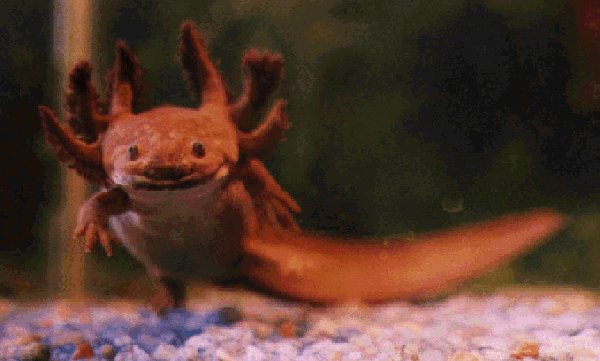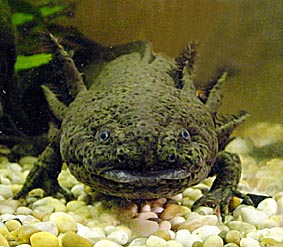Some time ago, I was at the aquarium in Niagara Falls and I saw the strangest animal there. There were actually about six of them in the tank of water. They were very pale, looked like they'd never seen daylight in a kajillion eons, and they had these frondy things like extra arms sticking out of their necks.

Photo from Jean Hardiwck, Ph.D.'s page, which describes how she uses axolotls and other creatures to study cardiac function.
The sign beneath the tank said the frondy things were their gills exposed. They looked like something out of a Simpsons episode. The person I was with was disgusted, then fascinated, but then disgusted again by them. The more I looked at them, the more I thought they looked like they'd be good to eat. Fleshy, not too many bones, no fur or hair or scales to worry about. The person I was with said, "Ugh, you want to EAT them?"
Yes. I did.
It turns out, these things are called Axolotls. The word is pronounced like it looks: Ax-uh-lo-tul. Here's another picture:

Photo linked from Steven Carr's page on the Origin of Evolutionary Novelty, Department of Biology, Memorial University of Newfoundland
- Axolotls are from Mexico. They are an aquatic amphibian, specifically a type of salamander.
- The name for these animals comes from an Aztec word, Nahuatl. The most commonly accepted translation for axolotl is "water dog."
- They originally lived in high-altitude, freshwater and volcanic lakes in a couple of regions of Mexico. But after one of their favorite lakes was filled in to make more room for Mexico City, they are now on the endangered species list, and most are raised in captivity.
- In the wild, Axolotls tend to be darker colored, most often sort of chocolate-colored. In captivity, they are often paler, ranging from gray to pale yellow to white albino.

Photo from Animalweb's page on amphibians
- Axolotls are often studied with great interest because if they lose a limb or other tissue, they can grow new limbs.
- Perhaps the reason they can regenerate tissue has to do with the second reason they fascinate scientists, which is that while most amphibians progress through three stages of growth, from egg to larva to adult, Axolotls stay in the larval stage their entire lives.
- They do reach sexual maturity, even while they are in their larval state, and though they do grow lungs, they continue to breathe primarily through their gills.
- If they are taken out of the water, they can breathe for a while through their skin, but only if the skin stays moist.
- If you want them to metamorphose into full adults, you can make it happen if you give them lots of iodine or a shot of a hormone called thyroxine. If you make them turn into adults, they'll only live about 5 years. If they stay in larval form, they'll live to be 10 or 15.
- It's speculated that the reason they don't become fully-grown adults on their own is that the freshwater lakes where they used to live didn't have enough iodine in them. But that's just a guess.

Photo from a German site on Axolotls
- Axolotls are carnivores. They will eat either live or dead food. They like lots of different kinds of worms, including earthworms, bloodworms (midge larvae), blackworms, or whiteworms. They can also eat Daphnia or brine shrimp. Breeders have also been known to feed their Axolotls chopped beef heart, but that's not the best choice becaues Axolotls can't digest mammal proteins very well.
- Axolotls have sort of stubby teeth, and they snap at their food, trapping it, then swallow it whole.
- They like it cold, preferring water temperatures around 60 degrees Fahrenheit.

Photo from the University of Kent
- They used to be a staple of the diet of Aztecs, and until very recently, they were sold in Mexican markets. People liked to eat them best roasted. So I am by far not the only person who thought they'd be good to eat.
Sources
Caudata.org, Axolotls
Wikipedia, Axolotl
About.com, Axolotls as Pets
Wellington Zoo, Axolotl
And you must read Julio Cortazar's amazing story, "Axolotl," from "Blow-Up."
ReplyDeleteNow that I think of it, the story enacts the best line of "As I Lay Dying": "My mother is a fish."
Well, sort of.
soooooooooooo cute!!! i want one soooooooooooo bad!!!!!
ReplyDelete